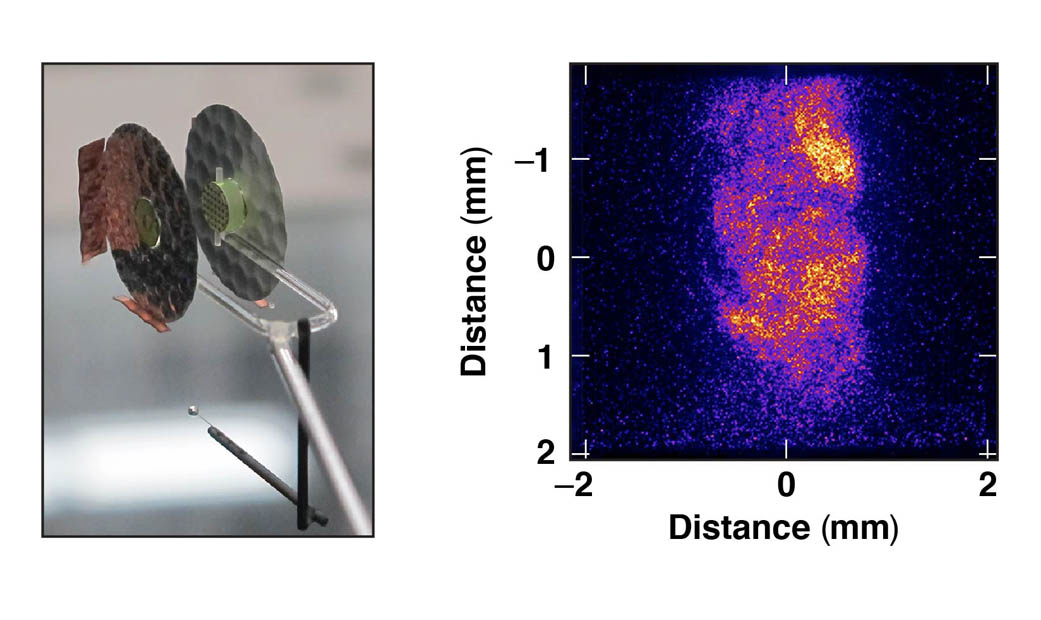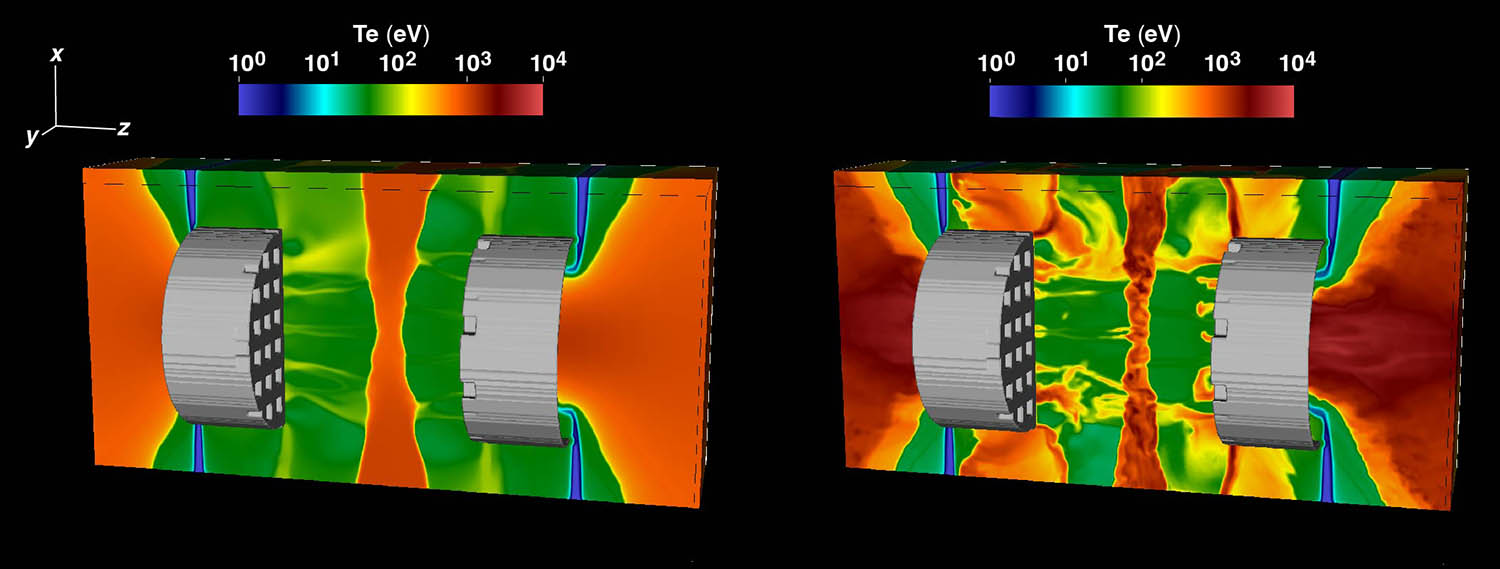Prof. Alexander Schekochihin, astrophysicist at the University of Oxford, who was involved in this work says: “How energy is injected into the plasma that fills galaxy clusters by the violently active galaxies at their centres, how it is then spread around and heats up the entire enormous system, producing the x-ray glow that observatories like Chandra pick up—these are fundamental questions about the largest building blocks of our universe. Both observations and the logic of our theoretical models suggest that heat conduction in these plasmas is strongly suppressed compared to naïve expectations. Several schemes for such suppression have been theorized about and simulated numerically, but very tentatively. Here suddenly we have it in a real laboratory plasma—and so experiment now has a chance to leapfrog theory in helping sort out the basic properties of an astrophysical plasma, an exciting prospect.”
To address these questions, Dr. Jena Meinecke, former Oxford Physics DPhil student and Junior Research Fellow at Christ Church, used the largest laser system in the world—the National Ignition Facility (NIF) at Lawrence Livermore National Laboratory (LLNL) in California—to create a replica of the plasma conditions expected to occur in the clusters of galaxies.
“The experiments conducted on the NIF are literally out of this world. Capable of bringing the powerful dynamics of the universe to the laboratory, the NIF truly provides opportunities to step into the unknown” says Meinecke.
In the experiments, laser beams were used to vaporize plastic foils and generate a turbulent and magnetized plasma, in similar fashion to the laser-driven experiments the team performed at the Laboratory for Laser Energetics (LLE) to demonstrate the turbulent dynamo mechanism for the first time.
“What is unique in these NIF experiments is that electrons in the plasma collide sufficiently infrequently with each other that they end up following the tangled magnetic-field lines” says Dr. Archie Bott, researcher at Princeton University (and former Oxford Physics DPhil student). “This phenomenon, which is precisely what is believed to occur in clusters of galaxies, gives rise to suppressed heat conduction.”
This effect is clearly seen in the laboratory data: the measurements show pockets of hot plasma that persist in time and heat cannot escape. Prof. Gianluca Gregori, who was the principal investigator in these experiments says “This work is an important stepping stone in understanding microscopic processes that occur in plasmas that are both magnetized and turbulent. The experimental findings are somehow surprising as they demonstrate that energy is transported in ways that are very different from what we would have expected from simple theories.”

Left: Photo of the TDYNO target deployed at the National Ignition Facility through the Discovery Science Program. The experimental target consists of two foils and a pair of grids, held together by cylindrical shields. Each target is about the size of a penny.
Photo credit: National Ignition Facility Operations Team.
Right: X-ray image of the turbulent plasma generated in the experiments, taken at 28 billionths of a second after the lasers fire. The hot plasma emits soft x rays, which enables the researchers to characterize the properties of the turbulent flow and measure the fluctuations of electron temperature that revealed the strong suppression of heat transport.

simulations of the TDYNO platform with Spitzer thermal conductivity turned on (left) and off (right), showing the electron temperature in electron volts, eV (1 eV corresponds to 11,333°C or 20,431°F). The strong magnetization of the plasma achieved at the NIF TDYNO experiments results in significant suppression of the thermal conduction, which in turn results in significant fluctuations in the electron temperature (right), which are reproduced in the FLASH simulation.
Image credit: Yingchao Lu, University of Rochester.
“This is indeed an astonishing result,” adds Prof. Petros Tzeferacos, director of the Flash Center of Computational Science, which recently moved from the University of Chicago to the University of Rochester and led the simulation efforts to design and help interpret the NIF experimental campaign. “To model the NIF experiments we brought to bear the full array of physics capabilities of FLASH, the multi-physics simulation code we developed. The FLASH simulations and our previous LLE experiments were key for untangling the physics at play in the turbulent, magnetized plasma and ensuring the success of the invaluable but few NIF shots; the level of thermal transport suppression, however, was beyond what we expected.”
While the simulations reproduce the experimental results by controlling the electron heat transport, they cannot to tell us what is the microscopic mechanism that is ultimately responsible for its observed suppression. Further work on the NIF laser is being prepared to look at the details of these interactions. “These experiments provide insight into complex physics processes and also raise additional questions that we hope to answer in upcoming NIF Discovery Science experiments with an optimized target design and diagnostic configuration,” says Dr. James Steven Ross, the liaison scientist of this project at LLNL.
These experiments demonstrate how laboratory explorations can help the understanding of astrophysical systems in a way that is complementary to observations. Prof. Don Lamb of the University of Chicago, also involved in the project, says “The Discovery Science Program at the National Ignition Facility—the most energetic laser in the world—made it possible for us to study fundamental physical processes that are essential to understanding the hot, tenuous, magnetized plasma in the cores of galaxy clusters.”
The research was carried out under the auspices of the U.S. Department of Energy (DOE) National Nuclear Security Administration (NNSA), the U.S. DOE Office of Science–Fusion Energy Sciences (FES), the National Science Foundation (NSF), the European Research Council (ERC), and the Engineering and Physical Sciences Research Council (EPSRC). The Discovery Science program of the U.S. DOE NNSA provided the collaboration with access to the NIF. Compute time for the FLASH numerical simulations was provided by the U.S. DOE ALCC and ERCAP programs, and the LLE High-Performance Computing group.
Original Article: Strong suppression of heat conduction in a laboratory replica of galaxy-cluster turbulent plasmas (science.org)


